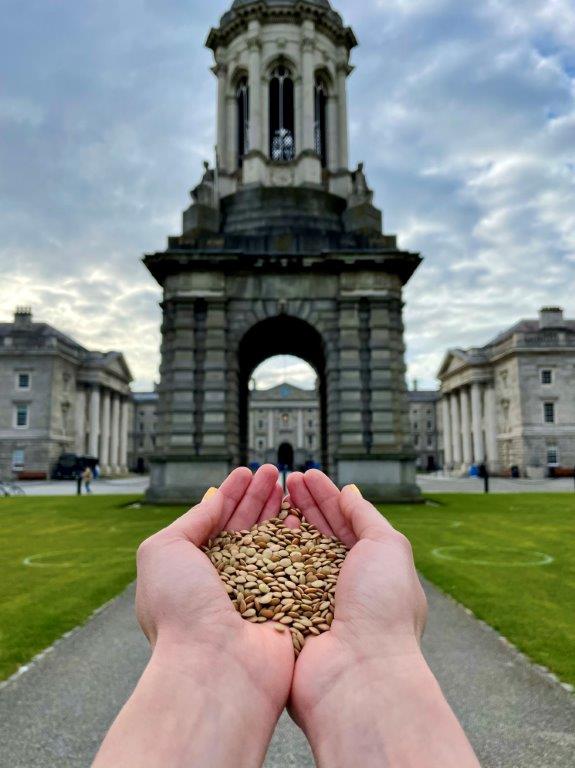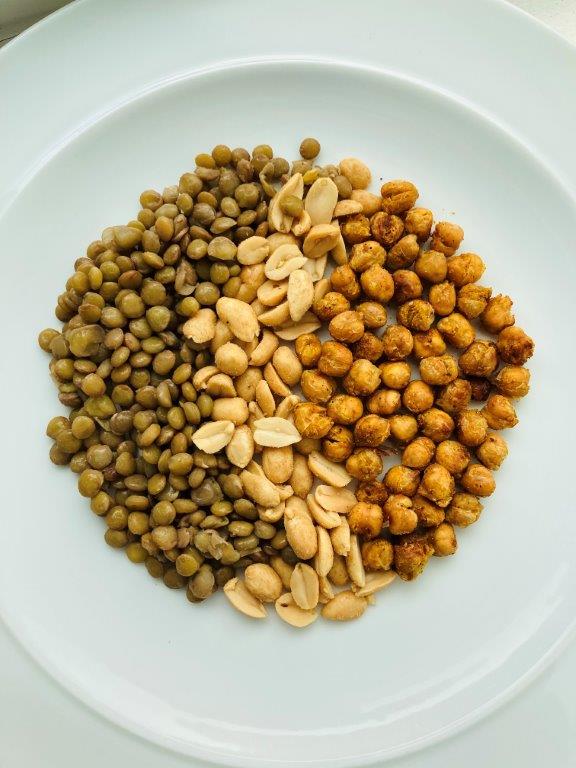Legumes: Fuelling your Body by Sustainable Means
By Emily MacInnis, 2nd year medical student
Let’s Talk Legumes
Legumes are a staple to any plant-based lifestyle, but you don’t need to be vegetarian or vegan to enjoy their benefits. Legumes are stapes in many diets around the globe.
But what is a legume you ask?
Well, they’re plants that produce pods which contain seeds. The term “legume” often refers to the seeds of these plants. Some common legumes are beans, lentils, peas, lupins, and peanuts to name a few. Legumes are packed with proteins, healthy fats, minerals, fibre etc. keeping you full longer and contributing to a healthy life. With mild flavours, legumes blend seamlessly into sauces, stir-fry, soups, and salads!
Why should I eat legumes?
Always hungry? The starches found in legumes take longer for ours bodies to digest then those found in cereals (5). This is beneficial as it prevents spiking of blood sugar levels which is of particular importance in the management of diabetes. Not to mention, it keeps you full longer helping to fuel your active lifestyle! Black beans burrito anyone? Or maybe just classic peanut butter on toast!
Legumes are an excellent source of protein due to their high nitrogen content. This has huge health implications as more and more evidence emerges linking red and processed meat consumption to diseases like coronary heart disease, colorectal cancer and type 2 diabetes (1). While protein content varies across species, legumes are enriched with essential amino acids our bodies can’t synthesize like lysine. Lupins and soybeans have particularly high protein content of 38-43% (2–4).
Legumes are also a great source of fibre promoting a healthy colon and even lowering blood cholesterol levels (2). Speaking of cholesterol, legumes don’t have any! If you’re conscious of cardiovascular health, legumes provide huge benefits. Studies have shown that legumes can decrease risk of cardiovascular disease and coronary heart disease by 10%-20% (6–8).
But wait, there are more heart benefits as legumes are low in sodium! Legumes are a good source of B vitamins like folate, important in red blood cell production and not to mention minerals like zinc, iron, calcium, potassium, magnesium etc (9). These minerals enable enzyme synthesis, nerve communication and heart contractions. Most legumes are low in fats with the exception of peanuts, chickpeas and soybeans. BUT, they are high in essential omega-3 and omega-6 fatty acids that can only be gained from the diet (2,3).
And the downsides?
Nothing can be perfect, but even the shortcomings of legumes are surmountable. Apart from soy, legumes tend to lack sulphur-containing amino acids (SCAA). While this could be problematic, there’s an easy fix! Cereals have high SCAA meaning eating legumes in combination with cereals makes a great protein-rich and delicious meal. Also, being low in SCAA increases calcium content of legumes which helps protect against bone demineralization2,3.
Legumes have high iron content, but low iron bioavailability meaning it is difficult for us to absorb9. Luckily, consuming vitamin C rich foods in combination with legumes significantly increases iron absorption2. This is as simple as eating beans with potatoes (rich in vitamin C)!
It's important to mention that legumes contain ‘anti-nutrients’ – chemicals that reduce our ability to absorb some minerals and digest protein. These compounds are NOT TOXIC, and they can be removed. You can purify legumes by soaking, steaming, boiling, and roasting prior to consumption/use2,10,11. Interestingly, some of these compounds have antioxidant properties helping prevent certain cancers, cardiovascular disease, and chronic degenerative diseases9,12.
And the Environmental Impact?
Legumes reduce the need for damaging fertilisers, particularly nitrates.
Nitrogen (N) is a necessary molecule to sustain life as it’s found in DNA, RNA and proteins. Naturally, plants need a healthy supply of N compounds to grow. This is why fertilisers are enriched with N compounds – to promote plant growth and increase crop yields. However, nitrogen-enriched fertilisers have negative environmental impacts – they produce large quantities of CO2 during their production and transport from the burning of fossil fuels13. Additionally, leakage of N compounds from agricultural run-off contaminates water sources endangering aquatic species. They also are a major contributor atmospheric N2O – a greenhouse gas (GHG) that is more powerful than CO214.
So you might be asking what do legumes have to do with nitrogen and fertilisers?
Legumes have a symbiotic relationship with the bacteria Rhizobia that occupy structures in the plant’s root called nodules. These organisms can fix N from the atmosphere into organic compounds in soil for plant usage. This reduces the need for N fertilisers and accompanying GHG emissions (15).
Other crops, like grains, require nitrogen rich fertilisers to yield enough crops to meet consumer demands. As fertiliser needs are reduced for legumes, they use 35% to 60% less fossil fuel energy in comparison to wheats13. Their ability to fix N in soil actually promotes growth of grains when planted in rotation and reduces the need of N fertilisers for these crops (14). Plus, legumes are hardy plants that thrive in poor soil conditions and adverse climates, they are pest resistant, and as cover crops, they reduce runoff which conserves our waterways (2).
Legumes have diverse roles in human consumption and environmental sustainability. Increasing your consumption not only serves to benefit you directly, but the plant as a whole! Here is legume salad for after a busy day.
As a student, it can be extremely challenging to maintain healthy habits with tight budgets and busy class schedules.
Legumes can be a solution! They are cheap and nutrient dense, plus with many dried and canned options, you don’t have to worry about them going off.
After a very hectic day, you may not feel like making a proper meal. If you have legumes like lentils, chickpeas, and peanuts around, grabb whatever veggies you have and whipp up a salad!
Little to no planning needed and a healthy snack after a long day!
References
1. Richi, E. B. et al. Health Risks Associated with Meat Consumption: A Review of Epidemiological Studies. Int. J. Vitam. Nutr. Res 85, 70–78 (2015).
2. Maphosa, Y. & Jideani, V. A. The Role of Legumes in Human Nutrition. in Functional Food - Improve Health through Adequate Food (InTech, 2017). doi:10.5772/intechopen.69127
3. Kouris-Blazos, A. & Belski, R. Health benefits of legumes and pulses with a focus on Australian sweet lupins. Asia Pacific Journal of Clinical Nutrition 25, 1–17 (2016).
4. Banaszkiewicz, T. Nutritional Value of Soybean Meal. in Soybean and Nutrition (InTech, 2011). doi:10.5772/23306
5. Phillips, R. D. Starchy legumes in human nutrition, health and culture. Plant Foods Hum. Nutr. 44, 195–211 (1993).
6. Çakir, Ö., Uçarli, C., Tarhan, Ç., Pekmez, M. & Turgut-Kara, N. Nutritional and health benefits of legumes and their distinctive genomic properties. Food Sci. Technol. 39, 1–12 (2019).
7. Bazzano, L. A. et al. Legume consumption and risk of coronary heart disease in US men and women: NHANES I Epidemiologic Follow-up Study. Arch. Intern. Med. 161, 2573–2578 (2001).
8. Marventano, S. et al. Legume consumption and CVD risk: A systematic review and meta-analysis. Public Health Nutrition 20, 245–254 (2017).
9. Messina, M. J. Legumes and soybeans: Overview of their nutritional profiles and health effects. in American Journal of Clinical Nutrition 70, 439s-450s (American Society for Nutrition, 1999).
10. Sánchez-Chino, X., Jiménez-Martínez, C., Dávila-Ortiz, G., Álvarez-González, I. & Madrigal-Bujaidar, E. Nutrient and nonnutrient components of legumes, and its chemopreventive activity: A review. Nutr. Cancer 67, 401–410 (2015).
11. Ndidi, U. S. et al. Effects of Processing (Boiling and Roasting) on the Nutritional and Antinutritional Properties of Bambara Groundnuts ( Vigna subterranea [L.] Verdc.) from Southern Kaduna, Nigeria . J. Food Process. 2014, 1–9 (2014).
12. Bouchenak, M. & Lamri-Senhadji, M. Nutritional quality of legumes, and their role in cardiometabolic risk prevention: A review. Journal of Medicinal Food 16, 185–198 (2013).
13. Jensen, E. S. et al. Legumes for mitigation of climate change and the provision of feedstock for biofuels and biorefineries. A review. Agronomy for Sustainable Development 32, 329–364 (2012).
14. Foyer, C. H., Nguyen, H. & Lam, H.-M. Legumes-The art and science of environmentally sustainable agriculture. Plant. Cell Environ. 42, 1–5 (2019).
15. Magrini, M. B. et al. Why are grain-legumes rarely present in cropping systems despite their environmental and nutritional benefits? Analyzing lock-in in the French agrifood system. Ecol. Econ. 126, 152–162 (2016).
Put Up Healthy Eating Posters
A student on the Healthy Eating Committee, Jessica, designed these posters. We're encouraging students and staff to put them up near where you study/work. Click on the pictures to download them. If you'd like some printed ones email Martina on health.promotion@tcd.ie
Healthy Eating On Campus
Eating healthily on campus is a combination of knowledge and choice. You can read more about balanced, healthy eating here (PDF, 68 kB) so that you have the tools to make healthy choices.
There are a wide variety of catering facilities on campus. The staff at catering services are well-informed about healthy eating and make every effort to provide healthy choices at all venues and at all times. Here are some of the positive changes that have been made in recent times:
- A healthy meal option is available every day
- Roast meats are cooked on racks to allow the fat to drain away
- Vegetable oil is used in cooking
- Vegetables are steamed and no butter is added to the finished products
- Low fat mayonnaise is used for salads
- Low fat dressings are available
- Wholemeal and brown breads are available as alternatives to white
- Healthy snacks are available in all areas. These are clearly labelled in a healthy eating section
Health Eating In College Accommodation
The Healthy Trinity: Healthy Eating Committee works with the Accommodation Office to ensure there is a good standard of cooking facilities in Trinity student accommodation. If you have any queries about cooking facilities in Trinity accommodation, please email Martina on health.promotion@tcd.ie. The Committee is interested in all feedback.
Healthy Recipes at a Low Cost
We love a goji berry as much as the next person but carrots are just as healthy and a lot cheaper. This book, 101+ Square Meals is full of great healthy recipes that are easy and cheap to make. We recommend it.
If you have any questions or suggestions about healthy eating on campus, please contact the health promotion officer at healthp@tcd.ie.


